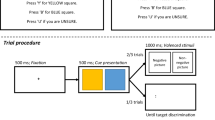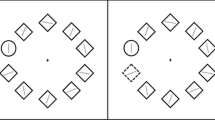Abstract
Cognitive views on anxiety have proposed that attentional biases towards threatening information in high trait anxious individuals play an important role in the maintenance of anxiety and may even cause the development of clinical anxiety disorders. However, the precise nature of these attentional biases is under debate. In a pictorial version of the dot probe task, two accounts of attention to threat were contrasted and the components of attention involved in orienting to threat were assessed. Overall, the results support the view that all individuals orient to highly threatening pictures, with high trait anxious individuals orienting more strongly to moderately threatening pictures than the low trait anxious individuals. Attentional bias to threat in high trait anxious individuals was caused by attentional disengagement from threat. These results are discussed in relation to cognitive models of attention to threat.

Similar content being viewed by others
Notes
See Koster et al. (2004) for more detail on selection of the affective pictures. The exact IAPS pictures can be provided by the authors upon request.
The congruency effect is determined by the higher-order interaction between picture position and probe position. Analyses incorporating Picture Position × Probe Position instead of congruency revealed the same significant interactions. No main effects of probe location and picture location were found (Fs < 1).
References
Beck, A. T., Emery, G., & Greenberg, R. L. (1985). Anxiety disorders and phobias: A cognitive perspective. New York: Basic Books.
Cohen, J. (1988). Statistical power analysis for the behavioural sciences. San Diego, CA: McGraw-Hill.
Derryberry, D., & Reed, M. A. (2002). Anxiety-related attentional biases and their regulation by attentional control. Journal of Abnormal Psychology, 111, 225–236.
Eysenck, M. W. (1992). Anxiety: The cognitive perspective. Hove: Erlbaum.
Fox, E., Russo, R., Bowles, R., & Dutton, K. (2001). Do threatening stimuli draw or hold visual attention in subclinical anxiety? Journal of Experimental Psychology: General, 130, 681–700.
Fox, E., Russo, R., & Dutton, K. (2002). Attentional bias for threat: Evidence for delayed disengagement from emotional faces. Cognition & Emotion, 16, 355–379.
Inquisit 1.32 (2001). Computer Software. Seattle, WA: Millisecond Software.
Kindt, M., van den Hout, M., de Jong, P., & Hoekzema, B. (2000). Cognitive bias for pictorial and linguistic threat cues in children. Journal of Psychopathology and Behavioral assessment, 22, 201–219.
Koster, E. H. W., Crombez, G., Verschuere, B., Van Damme, S., Wiersema, J.-R. (in press). Components of attentional bias to threat in high trait anxiety: Facilitated engagement, impaired disengagement, and attentional avoidance. Behaviour Research and Therapy.
Koster, E. H. W., Crombez, G., Verschuere, B., & De Houwer, J. (2004). Selective attention to threat in the dot probe paradigm: Differentiating vigilance and difficulty to disengage. Behaviour Research and Therapy, 42, 1183–1192.
Lang, P. J. (1980). Behavioural treatment and the bio-behavioural assessment: computer applications. In J. B. Sidowski, J. H. Johnson, & T. A. Williams (Eds.), Technology in mental health care delivery systems (pp. 119–137). Norwood, NJ: Ablex.
Lang, P. J., Bradley, M. M., & Cuthbert, B. N. (1999). International pictures system (IAPS): Technical manual and affective ratings. Gainesville, FL: The Center for research in Psychophysiology.
MacLeod, C., Campbell, L., Rutherford, E., & Wilson, E. (2004). The causal status of anxiety-linked attentional and interpretive bias. In J. Yiend (Ed.), Cognition, emotion and psychopathology (pp. 172–189). Cambridge: Universities Press.
MacLeod, C., & Hagan, R. (1992). Individual differences in the selective processing of threatening information, and emotional responses to a stressful life event. Behaviour Research and Therapy, 30, 151–161.
MacLeod, C., & Mathews, A. (1988). Anxiety and the allocation of attention to threat. Quarterly Journal of Experimental Psychology, 40, 653–670.
MacLeod, C., Mathews, A., & Tata, P. (1986). Attentional bias in emotional disorders. Journal of Abnormal Psychology, 95, 15–20.
MacLeod, C., Rutherford, E., Campbell, L., Ebsworthy, G., & Holker, L. (2002). Selective attention and emotional vulnerability: Assessing the causal basis of their association through the experimental manipulation of attentional bias. Journal of Abnormal Psychology, 111, 107–123.
Mathews, A., & Mackintosh, B. (1998). A cognitive model of selective processing in anxiety. Cognitive Therapy and Research, 22, 539–560.
Mogg, K., & Bradley, B. P. (1998). A cognitive-motivational analysis of anxiety. Behaviour Research and Therapy, 36, 809–848.
Mogg, K., McNamara, J., Powys, M., Rawlinson, H., Seiffer, A., & Bradley, B. P. (2000). Selective attention to threat: A test of two cognitive models of anxiety. Cognition & Emotion, 14, 375–399.
Spielberger, C. D., Gorsuch, R. L., Lushene, R., Vagg, P. R., & Jacobs, G. A. (1983). Manual for the state-trait anxiety inventory. Palo Alto, CA: Consulting Psychologists Press.
Verschuere, B., Crombez, G., & Koster, E. (2001). The international affective picture system: A cross-cultural validation study. Psychologica Belgica, 41, 205–217.
Williams, J. M. G., Watts, F. N., MacLeod, C., & Mathews, A. (1988). Cognitive psychology and emotional disorders. Chichester: Wiley.
Williams J. M. G., Watts F. N., MacLeod C., & Mathews, A. (1997). Cognitive psychology and emotional disorders (2nd ed.). Chichester: Wiley.
Wilson, E., & MacLeod, C. (2003). Contrasting two accounts of anxiety-linked attentional bias: Selective attention to varying levels of stimulus threat intensity. Journal of Abnormal Psychology, 112, 212–218.
Yiend, J., & Mathews, A. (2001). Anxiety and attention to threatening pictures. Quarterly Journal of Experimental Psychology A, 54, 665–681.
Acknowledgment
Ernst Koster is postdoctoral fellow of the Fund for Scientific Research, Flanders (Belgium) (FWO).
Author information
Authors and Affiliations
Corresponding author
Rights and permissions
About this article
Cite this article
Koster, E.W., Crombez, G., Verschuere, B. et al. Attention to Threat in Anxiety-prone Individuals: Mechanisms Underlying Attentional Bias. Cogn Ther Res 30, 635–643 (2006). https://doi.org/10.1007/s10608-006-9042-9
Published:
Issue Date:
DOI: https://doi.org/10.1007/s10608-006-9042-9




